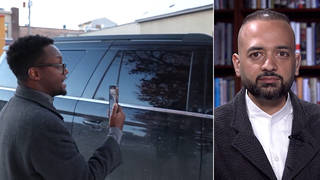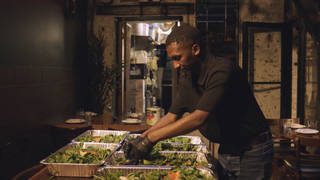
Guests
- Nick Estesassistant professor of American studies at the University of New Mexico and author of the book, Our History Is the Future.
Lakota historian Nick Estes talks about Thanksgiving and his book “Our History Is the Future,” and the historic fight against the Dakota Access pipeline at Standing Rock. “This history … is a continuing history of genocide, of settler colonialism and, basically, the founding myths of this country,” says Estes, who is a co-founder of the Indigenous resistance group The Red Nation and a citizen of the Lower Brule Sioux Tribe.
Transcript
AMY GOODMAN: In this special broadcast, we begin the show with the Indigenous scholar and activist Nick Estes. He’s co-founder of the Indigenous resistance group The Red Nation and a citizen of the Lower Brule Sioux Tribe. His books include Our History Is the Future, which tells the history of Indigenous resistance over two centuries, offering a road map for collective liberation and a guide to fighting life-threatening climate change. Estes centers this history in the historic fight against the Dakota Access pipeline at Standing Rock. I asked him to talk about the two Thanksgiving stories he writes about at the beginning of his book.
NICK ESTES: So, the first Thanksgiving story is — begins with the Pequot massacre by members of the Massachusetts Bay Colony, which really marks sort of — in my opinion, marks sort of the mythology of the United States as a settler-colonial country founded on sort of genocide to create, ironically, peace. And then I begin with another story of a prayer march that we led in the Bismarck mall in Bismarck, North Dakota, to kind of bring attention to the Standing Rock struggle during a Black Friday shopping event, which was met by police armed with AR-15s, who then began punching and kicking water protectors who were holding a prayer in the Bismarck mall.
And I thought it was a really kind of jarring sort of contrast between, you know, the past and the present, to say that while there are sort of differences between the massacre of Pequots in Massachusetts to the contemporary sort of fight against an oil pipeline, nonetheless, you know, Bismarck, North Dakota, is a 90% white community that originally the Dakota Access pipeline was supposed to go upriver from, but then was rerouted downriver to disproportionately affect the Standing Rock Sioux Tribe. And “disproportionate” is the language that the Army Corps of Engineers used, as if there’s ever a proportionate risk to environmental issues and water contamination. So, at this particular moment, there weren’t any actions that were happening in the camps, and it was largely at a standstill. And I think that Thanksgiving weekend, there was an Unthanksgiving feast that was held in the camps, and it was actually the highest point of the camps themselves, in the sense that there were the most sort of water protectors had showed up. So, I thought it was a good kind of contrast to show that this history, you know, is a continuing history of genocide, of settler colonialism and, basically, the founding myths of this country.
AMY GOODMAN: Your book’s last words are, “[W]e are challenged not just to imagine, but to demand the emancipation of earth from capital. For the earth to live, capitalism must die.” Explain.
NICK ESTES: So, that line is part of this longer section on liberation. And I think when we think about climate change, oftentimes the question of climate change really centers on market-driven solutions, such as, you know, green capitalism, and how do we create markets that sort of incentivize transition to sustainable economies, right? And I think, really, what we’re kind of like beating around the bush is, is that it’s the system of capitalism that led us into this economic crisis to begin with. It’s the sort of designation of certain populations in certain territories as disposable, that has led us into our current epoch of global climate change. And so, when we talk about who’s going to bear the most burden when we transition, you know, out of the carbon economy, it most likely is going to be those populations that have historically been colonized, you know.
And, you know, what’s happening in southeast Africa is a perfect example of why we need to transition away from not just the carbon economy, but capitalist economies in general, because if we look at the history of how Africa has been a resource colony for Europe and for North America, we can look internally in the United States and understand that Indigenous nations continue to serve as resource colonies for the United States, whether it’s the Navajo Nation, where I’m living right now, that is producing oil and coal to generate electricity for the Southwest region, or whether it’s the Fort Berthold Reservation up in North Dakota, that is, you know, ground zero for oil and gas development in the Bakken region. We have to understand that Indigenous nations have largely been turned into resource colonies and sites of sacrifice for not just the United States, but for the oil and gas industry.
And so we need to not just think beyond climate change and putting carbon into the atmosphere, but we actually need to think about the system, the social system — right? — that created those conditions in the first place. And so, capitalism is fundamentally a social relation. It’s a profit-driven system, whereas Indigenous sort of ways of relating is one about reciprocity and a mutual sort of respect, not just with the human, but also with the nonhuman world. And we’re undergoing, you know, the sixth mass — sixth massive extinction event, which is caused by not just climate change, but is caused by capitalist sort of systems and the profit-driven sort of motive of our current economic and social system.
AMY GOODMAN: Nick Estes, you focus on seven historical moments of resistance in your new book, Our History Is the Future. You say they form a historical road map for collective liberation. How did you choose these histories? Just quickly take us through them.
NICK ESTES: Sure. So, I begin at the camps. I begin in the present, you know, at Standing Rock. And then I go to the fur trade with the first U.S. invasion, which was Lewis and Clark, who came through — who trespassed through our territory and were stopped by our leadership. And then I go through the Indian Wars of the 19th century and the buffalo genocide. And then I go into talking about the damming of the Missouri River in the mid-20th century, and then looking at Red Power in the 1960s and in the 1970s and how all of these Indigenous people, who were relocated because their lands were flooded by these dams, eventually found themselves and created sort of the modern Indigenous movement, known as Red Power, and then looking — going back and ending actually at Standing Rock in 1974, with the creation of the International Indian Treaty Council, which really coalesced these generations of Indigenous resistance and took the treaties, the 1868 Fort Laramie Treaty, to the world and to the United Nations. And to do that, they looked to Palestinians, they looked to the South African anti-apartheid movement, who provided the mechanisms for recognition of Indigenous rights at the United Nations. And that all resulted, over four decades, in the touchstone document, the United Nations Declaration on the Rights of Indigenous Peoples, which was passed by the U.N. in 2007.
And so, in many ways, when we look at Standing Rock, and we look at — if we go down flag row and we see the hundreds of tribal nation flags that were represented in 2016 and 2017, we also saw the Palestinian flag that was there, kind of hearkening back to that international solidarity with movements of the Global South, and specifically our Palestinian relatives, who, you know, today are still facing — much like us, are still facing the brunt and the brutality of settler colonialism, whether it’s, you know, the United States recognizing the annexation of the Golan Heights or whether it’s, you know, here in North America and the continued dispossession of Indigenous territory and rights. We can see that settler colonialism in Israel — or, in Palestine, is really an extension of settler colonialism in North America.
And so — and then I end, you know, with — back at the camps and looking at how these camps really provided — you know, I actually look at a physical map that was handed out to water protectors who came to the camp. And on that map there was, you know, where to find food, where to find the clinics — right? — and where to find the security, and all the camps that were represented at Standing Rock. And, to me, that provided, you know, a kind of interesting parallel to the world that surrounded the camps, which was 90 — you know, some 92 different law enforcement jurisdictions. You had the North Dakota National Guard, the world of cops, the world of the militarized sort of police state. And in the camps themselves you had sort of the primordial sort of beginnings of what a world premised on Indigenous justice might look like. And in that world, you know, everyone got free food. There was a place for everyone. You know, the housing, obviously, was transient housing and teepees and things like that, but then also there was health clinics to provide healthcare, alternative forms of healthcare, to everyone. And so, if we look at that, it’s housing, education — all for free, right? — a strong sense of community. And for a short time, there was free education at the camps, right? Those are things that most poor communities in the United States don’t have access to, and especially reservation communities.
But given the opportunity to create a new world in that camp, centered on Indigenous justice and treaty rights, society organized itself according to need and not to profit. And so, where there was, you know, the world of settlers, settler colonialism, that surrounded us, there was the world of Indigenous justice that existed for a brief moment in time. And in that world, instead of doing to settler society what they did to us — genociding, removing, excluding — there’s a capaciousness to Indigenous resistance movements that welcomes in non-Indigenous peoples into our struggle, because that’s our primary strength, is one of relationality, one of making kin, right?
AMY GOODMAN: Nick Estes, Indigenous scholar and activist, speaking in 2019. His books include Our History Is the Future. He’s co-founder of the Indigenous resistance group The Red Nation and a citizen of the Lower Brule Sioux Tribe.
When we come back, Dr. Gabor Maté on The Myth of Normal: Trauma, Illness, and Healing in a Toxic Culture.












Media Options